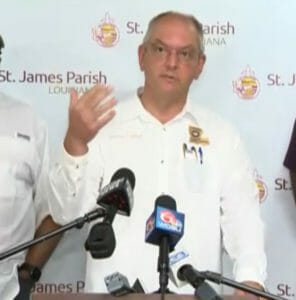
Seven nursing home residents have now died after being shipped to a warehouse in advance of Hurricane Ida, and Louisiana officials have ordered the temporary closure of the seven nursing homes where they lived.
The developments came as state and local agencies tussled over who would investigate the deaths and the decisions that led up to them. Health officials at multiple sites also were concerned about the spread of infectious disease — including COVID-19 — after patients had been kept in close quarters with little or no apparent infection prevention efforts.
On Saturday, the Louisiana Department of Health issued an emergency order prohibiting nursing home owner Bob Dean or anyone else from “repatriating” residents back to the original nursing homes.

State Health Officer Joseph Kanter, M.D., said he was making the order “for the purposes of controlling nuisances dangerous to the public health and communicable, contagious, and infectious diseases, and any other danger to the public life, health and safety.”
It will remain in effect for all seven nursing homes through at least Sept. 10, or until the health department can finish a full investigation of the evacuation.
Outrage at the evacuation’s failed execution mounted through the weekend, as more details emerged and the death toll mounted. The state has now attributed five of seven resident deaths that occured after the evacuation as “storm-related” but released no further details on the causes.
While state officials initially approved the warehouse in Independence as a temporary shelter, they have said they were rebuffed when they tried to return and investigate complaints after Ida came ashore as a Category 4 storm.
Workers who tried to care for the displaced residents have since reported that power outages led to up to two days without air conditioning. Video also showed water had infiltrated the building at some point, covering parts of the concrete floor where mattresses were arranged close together.
The Times-Picayune/The Advocate reported Saturday that Dean had filed plans outlining an emergency transfer for up to 700 residents. But the 843 eventually moved there exceeded that maximum by about 20%. Local officials also said they had been told to expect about half that amount.
Louisiana Department of Health spokeswoman Aly Neel said in a statement that the facility initially provided “the minimum necessary components to provide a safe sheltering environment for a very short period of time were met.” But after generators failed and resident complaints mounted, she said, Dean “failed to communicate the dire situation to the state and ask for help.”
Hospitals reported that residents later rescued from the holding facility arrived without needed medications and without having eaten in the last day.
An LDH spokeswoman told local media it is also pursuing “permanent regulatory action” against Dean’s nursing homes, six of which have one-star ratings.
The department has yet to respond to McKnight’s questions about other facilities Dean might own, citing the need for legal review.
Dean, meanwhile, has told local media that the number of deaths per day among a crowd of 800-plus nursing home residents is “normal,” and criticized officials for removing residents from the warehouse without his permission.
Previous evacuation problems comes to light
This evacuation is raising familiar questions about whether it is better to shelter fragile nursing home residents in place or to evacuate them during weather emergencies.
The deaths of 12 residents of a Florida nursing home following Hurricane Irma in 2017 led to charges against several staff members and new laws requiring back-up power supplies. As in this case, the provider had an emergency plan on file but conditions changed rapidly after power was lost.
Dean, the owner of the Louisiana nursing homes, isn’t new to criticism of his severe weather responses. He has previously used vacant warehouses he owns — including an old Winn-Dixie grocery building — as holding facilities.
A nurse who worked on evacuating his facilities during Hurricane Gustav in 2008 and during Ida said major issues at both times were caused by inadequate supplies, with Ida’s evacuation complicated by understaffing too.
During 1998’s Hurricane Georges, two of Dean’s residents died during or shortly after evacuation on a non-air conditioned bus. The warehouse they were headed to was then shut down for violating fire codes, and Dean paid a $1,000 fine, according to The Times-Picayune/The Advocate.

Gov. John Bel Edwards (D) said during a Sunday press conference that evacuation in the face of a “very, very powerful storm” is the “proper thing to do.”
“That’s always a tough call because you’re dealing with a very frail and fragile population … just the act of moving them can unfortunately bring about deaths,” Edwards said. “The question is whether we are doing (evacuations) the way that we should and whether we’re learning and incorporating those lessons learned.”
Edwards noted that dozens of other nursing homes in the state evacuated to temporary shelters that were “sufficiently hardened” and did not deteriorate after landfall.
Louisiana Attorney General Jeff Landry (R) said he will investigate the deaths, as the police chief in Independence and the sheriff of Tangipahoa Parish, where the warehouse is located, said they were too overwhelmed by continuing hurricane response to do so immediately.
A Tangipahoa Parish official said the sheriff’s office had also asked him to contact the U.S. Department of Health and Human Services to request an investigation.
COVID infections found
Public health officials already burdened by ongoing storm deaths and broader concerns about heat and power outages may also have new COVID-19 concerns on their hands.
About one-quarter of shelter evacuees were taken to the Bossier Civic Center, where doctors evaluated them for COVID-19 and other medical concerns. Peter Seidenberg, chair of family medicine at the LSU Health Shreveport School of Medicine, told the Washington Post this weekend that two of the evacuees tested positive for coronavirus.
The shelter has now been split into three sections: one for isolation; another for those who came from Dean’s warehouse; and another for all other evacuees.
Meanwhile, with the closure of the seven original facilities, more than 800 residents remained in search of a longer-term home. Hundreds were scattered to remote shelters and some sent to nursing homes hours away.
The Louisiana Nursing Home Association said Dean’s seven facilities are not among its members, but some of the organization’s members have been assisting in the evacuation and relocation effort.“
LNHA’s member nursing facility staff members have worked tirelessly and selflessly to protect the health and safety of their residents during this weather event,” Executive Director Mark Berger told McKnight’s. “Many staff members have had damage to their homes, yet they have left their families during a very challenging time to provide person-centered quality care to the residents they serve. They are truly our healthcare heroes.”




